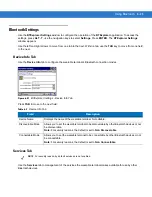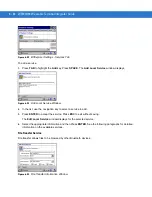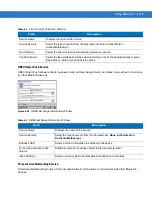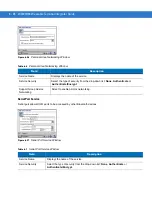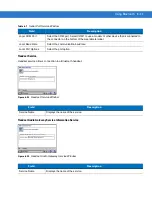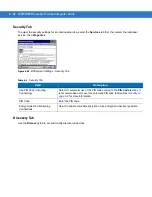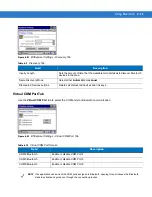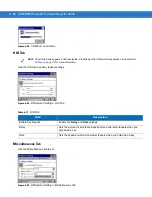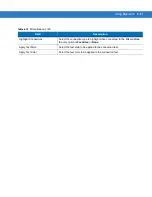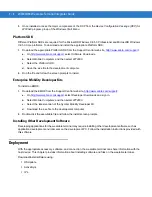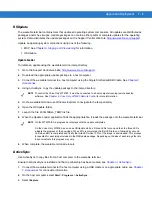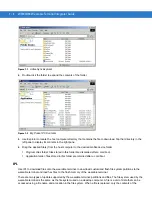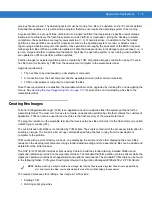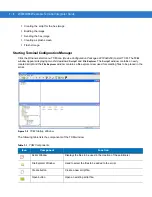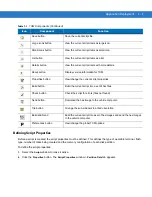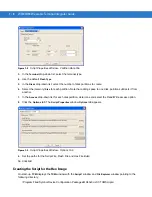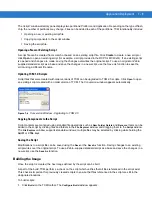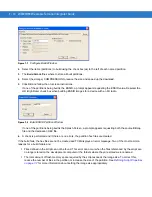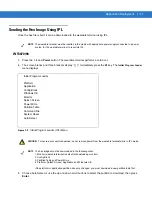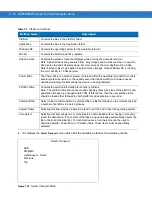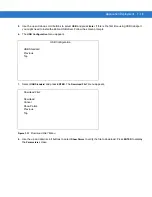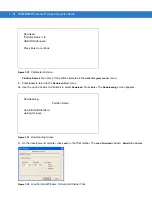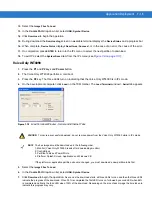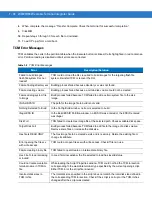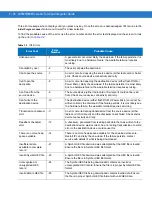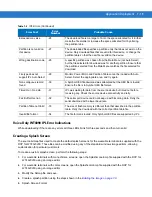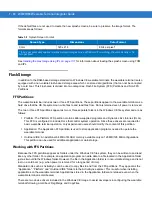
Application Deployment
7 - 5
previous file are erased. The operating system must be running for a file to be updated, so the IPL cannot perform
individual file updates as it is a stand-alone program that does not require the operating system to be running.
A typical partition is a group of files, combined into a single “partition” that represents a specific area of storage.
Examples of partitions are the flash file systems such as
Platform
or
Application
. (Using the desktop computer
comparison, these partitions are roughly equivalent to a C: or D: hard disk drive.) In addition to the “hard disk”
partitions, some partitions are used for single items such as the operating system, monitor, or splash screen.
(Again using a desktop computer comparison, these partitions are roughly the equivalent of the BIOS or special
hidden system files.) When a partition is updated, all data that was previously in its storage region is erased - i.e. it
is not a merge but rather a replacement operation. Typically, the operating system is not running when partitions
are updated, so IPL can perform partition updates.
Partition images for selected partitions can be created by TCM. All partition images suitable for use by IPL are in
hex file format for transfer by TCM from the development computer to the wearable terminal.
Upgrade requirements:
•
The hex files to be downloaded (on development computer)
•
A connection from the host computer and the wearable terminal (either serial or wireless)
•
TCM (on development computer) to download the files.
Once these requirements are satisfied, the wearable terminal can be upgraded by invoking IPL and navigating the
menus. See
Sending the Hex Image Using IPL on page 7-11
for procedures on downloading a hex file to the
wearable terminal.
Terminal Configuration Manager (TCM) is an application used to customize flash file system partitions for the
wearable terminal. The most common use is to create an application partition hex file that contains the customer's
application. TCM can also be used to load hex files to the flash memory of the wearable terminal.
The program resident on the wearable terminal that receives the hex file and burns it to the flash memory is called
Initial Program Loader (IPL).
The customization of partitions is controlled by TCM scripts. The scripts contain all of the necessary information for
building an image. The script is a list of copy commands specifying the files to copy from the development
computer to the partition.
TCM works with a pair of directory windows, one displaying the script and the other displaying the source files
resident on the development computer. Using standard windows drag and drop operations, files can be added and
deleted from the script window.
The DCP for WT40x0c50 includes scripts used by Zebra to build the standard factory installed
Platform
and
Application
partitions provided on the wearable terminal. The standard
Platform
partition contains drivers while the
Application
partition contains demo applications and optional components. The standard TCM scripts can be found
in the following folder:
C:\Program Files\Symbol Device Configuration Packages\WT40x0c50 v1.0\TCM Scripts.
The required processes for building a hex image in TCM include:
•
Starting TCM
•
Defining script properties
NOTE
Before creating a script to build a hex image, identify the files required (system files, drivers, applications,
etc.) and locate the files’ source directories to make the script building process easier.
Summary of Contents for WT4090
Page 1: ...WT4070 90 Wearable Terminal Integrator Guide ...
Page 2: ......
Page 3: ...WT4070 90 Wearable Terminal Integrator Guide 72E 87638 07 Rev A April 2015 ...
Page 6: ...iv WT4070 90 Wearable Terminal Integrator Guide ...
Page 14: ...xii WT4070 90 Wearable Terminal Integrator Guide ...
Page 20: ...xviii WT4070 90 Wearable Terminal Integrator Guide ...
Page 55: ...Accessories 2 25 Figure 2 25 Disconnecting Connector with Shroud Connector Eject Hole ...
Page 56: ...2 26 WT4070 90 Wearable Terminal Integrator Guide ...
Page 62: ...3 6 WT4070 90 Wearable Terminal Integrator Guide ...
Page 66: ...4 4 WT4070 90 Wearable Terminal Integrator Guide ...
Page 138: ...6 32 WT4070 90 Wearable Terminal Integrator Guide ...
Page 162: ...8 2 WT4070 90 Wearable Terminal Integrator Guide ...
Page 166: ...9 4 WT4070 90 Wearable Terminal Integrator Guide ...
Page 190: ...A 12 WT4070 90 Wearable Terminal Integrator Guide ...
Page 205: ......

